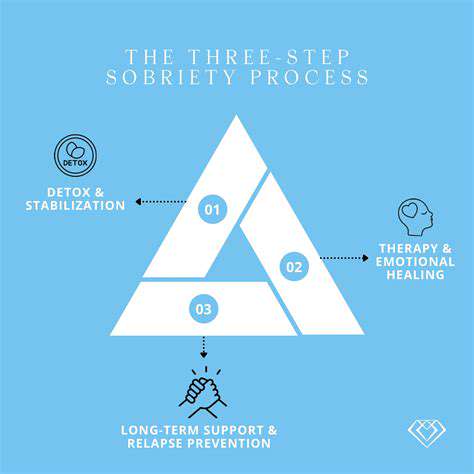Khám phá những điều giúp ích cho các cơn hoảng loạn lo âu: Danh sách nguồn lực
Grounding Techniques for Immediate Relief
Deep Breathing Exercises
Deep breathing exercises are a cornerstone of many grounding techniques, offering immediate relief from anxiety. Incorporating slow, deliberate breaths can significantly reduce feelings of panic and overwhelm. By focusing on the physical act of inhaling and exhaling, you shift your attention away from racing thoughts and anxious sensations. Practice slow, deep breaths, filling your lungs completely and exhaling slowly and fully. Notice the sensation of the air entering and leaving your body. This mindful focus can be surprisingly effective in calming the nervous system.
Another helpful technique within deep breathing is box breathing. This involves inhaling for a count of four, holding your breath for a count of four, exhaling for a count of four, and holding your breath again for a count of four. Repeating this cycle helps regulate your breath and create a sense of calm and control over your body's response to anxiety.
Mindful Sensory Awareness
Grounding techniques often involve bringing your attention to the present moment through your senses. Notice the textures of things around you – the softness of a blanket, the coolness of a surface, the roughness of a book. Pay attention to the sounds – the gentle hum of a refrigerator, the chirping of birds, the rhythm of your own heartbeat. Engage all your senses to anchor yourself in the present moment, rather than dwelling on anxieties about the future or regrets about the past.
Focusing on the taste and smell of something can also be a powerful grounding tool. Take a sip of water, noticing the temperature and the taste. Smell a flower or a cup of coffee, paying close attention to the aroma. These sensory details help to shift your focus away from anxious thoughts and provide a connection to the present experience.
Progressive Muscle Relaxation
Progressive muscle relaxation involves systematically tensing and releasing different muscle groups in your body. By consciously tightening and then releasing each muscle group, you become aware of the physical sensations of tension and relaxation. This process helps to reduce physical tension associated with anxiety, which can often contribute to heightened feelings of unease. Start with your toes, clenching them tightly for a few seconds and then releasing. Continue this process, moving through different muscle groups in your body, such as your calves, thighs, and arms, until you reach your head.
This technique not only helps alleviate physical tension but also cultivates a sense of body awareness, which is crucial in managing anxiety. As you become more attuned to your body's physical sensations, you'll be better equipped to recognize and respond to anxious feelings before they escalate.
Creating a Safe and Grounded Space
Sometimes, creating a physical space that promotes feelings of safety and grounding can be incredibly helpful in managing anxiety. This could involve decorating your home or workspace with calming colors, objects, or nature elements, such as plants. Creating a designated space can be a physical reminder of a sense of calm and security. This space can be a physical environment or a mental one, a safe place you can visit in your mind to feel calmer, grounding yourself when anxiety takes over.
Surrounding yourself with comforting items and ensuring that your surroundings are organized and clutter-free can also contribute to a sense of peace and control. Having a designated quiet space, free of distractions, can be beneficial for grounding yourself in moments of anxiety, allowing you to refocus and regain composure.


Seeking Professional Help and Support

Seeking Professional Help for Mental Health
Facing challenges with your mental well-being is a courageous step towards self-improvement. Recognizing the need for professional help is a sign of strength and a commitment to prioritizing your mental health. Many individuals struggle in silence, feeling ashamed or embarrassed about their experiences. However, seeking professional help is a proactive and healthy approach, demonstrating a commitment to your overall well-being.
Mental health professionals can provide a safe and supportive environment for you to explore your feelings and experiences. They offer evidence-based tools and strategies to navigate difficult emotions and develop coping mechanisms. They can help you identify patterns, understand triggers, and develop healthier ways of responding to situations.
Understanding the Benefits of Therapy
Therapy offers a structured and confidential space for personal growth and healing. It empowers you to understand yourself better, identify your strengths, and address any underlying issues that may be impacting your well-being. Through therapy, you can develop a deeper understanding of your thoughts, feelings, and behaviors, leading to more fulfilling relationships and a greater sense of self-awareness.
Professional guidance can help you develop coping mechanisms for stress, anxiety, and depression. This can lead to improved emotional regulation and a more positive outlook on life. It's important to remember that seeking therapy doesn't define you; it's a proactive step towards reclaiming your well-being.
Different Types of Mental Health Professionals
Various mental health professionals, such as psychiatrists, psychologists, and social workers, offer specialized expertise and support. Psychiatrists are medical doctors who can prescribe medication to address specific mental health conditions. Psychologists specialize in assessing and treating psychological issues, while social workers focus on providing support and resources to help individuals navigate various challenges. Understanding the different roles and specializations can help you choose the most suitable professional for your needs.
Choosing the Right Therapist for You
Finding a therapist who resonates with you is crucial for a successful therapeutic journey. Consider factors like their experience, specialization, and approach to therapy when making your decision. Researching therapists and reading reviews can provide valuable insights into their practices and client testimonials. Don't hesitate to reach out for consultations to determine if their approach aligns with your needs and preferences.
Building a strong rapport with your therapist is fundamental to a positive therapeutic experience. Open communication and trust are essential elements in fostering a safe and supportive environment for growth and healing. Discuss your expectations and concerns openly, and don't hesitate to voice any discomfort or dissatisfaction.
Finding Resources and Support Systems
Seeking support from family, friends, or support groups can augment your therapeutic journey. Talking to loved ones about your experiences can provide emotional validation and a sense of connection. Support groups offer a platform to connect with others who share similar experiences, providing encouragement and understanding. Additionally, numerous online resources and helplines offer valuable information and support during challenging times.
Remember, you are not alone in your journey toward mental well-being. Many resources are available to provide support and guidance. Don't hesitate to reach out and seek the help you deserve.